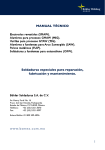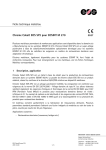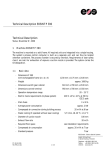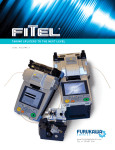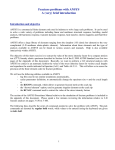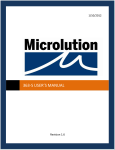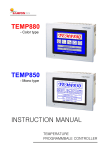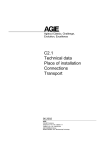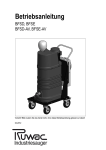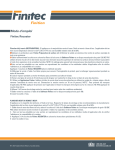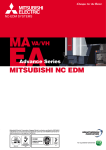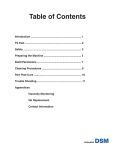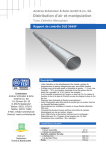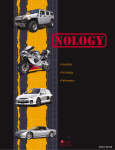Download Technical Description EOSINT M 280 Technical description
Transcript
Technical Description EOSINT M 280 Technical description Status: December 2010 1 EOSINT M 280 The machine comprises a process chamber with recoating system, elevating system and platform heating module, an optical system with laser, a process gas management system, a process computer with process control software, and a set of standard accessories. The machine components are integrated into a robust machine frame. During operation the process chamber is secured by interlock. Requirements of laser safety class 1 are met. When closed, the control cabinet’s specifications correspond to IP 54. The system carries the CE designation. Technical Description EOSINT M 280 1.1 Basic data - dimensions (w x d x h) 2200 mm x 1070 mm x 2290 mm - weight approx. 1250 kg (without powder) - mains supply (three phase system) - mains fuse protection - maximum power consumption (incl. cooler) - compressed air supply - argon supply - min. argon purity: purity 99.998 % argon 400 V +6 %/-10 % at 50/60 Hz 3 x 32 A 5.5 kW 7,000 hPa; 20 m³/h 4,000 hPa; 100 l/min Argon 4.8 Full details including required floor space, connections and environmental requirements (temperature and humidity range etc.) are given in the Installation Conditions. 1.2 Optical system The optical system creates and positions the laser beam to fuse (melt or otherwise solidify) the powder material. The laser emits a laser beam which is guided by an optical fibre, a beam expander optic, the scanner mirrors and a focussing objective. All optical surfaces have special coatings to guarantee effective beam guidance. 1.2.1 Laser - Yb (Ytterbium) fibre laser - wavelength - nominal power SW, 12/2010 1060 - 1100 nm 200 W or 400W (optional) 2 / 33 Technical Description EOSINT M 280 1.2.2 Scanner The scanner is a high-speed scanner unit comprising precision galvanometer scanners with temperature compensation, actively cooled ultra-high reflection mirrors, integrated servoand interface electronics, digital data transfer from the system's control computer and digital signal processing. It also incorporates an integrated home-in sensor, which detects and corrects any scanner drift at regular intervals. A high positional stability of the laser beam is thereby maintained even under varying environmental conditions or with high thermal loading due to long exposure times and large building jobs. - exposure area - exposure speed - repeatability, scanner position 1.2.3 250 mm x 250 mm up to 7000 mm/s < 11 µrad Focussing objective The focussing objective is a so-called F-theta objective, which focuses the laser beam onto a flat field. Below the F-theta objective is a protective glass, with a pneumatic lens protection device which prevents dirt settling on the lens surface. The laser beam focus is automatically switched between two pre-defined sizes during the exposure using a dual focus system: a fine focus is typically used for accurate exposure of contours and a broader focus for fast exposure of larger areas. The sizes are manually selected according to the material being used. - diameter of laser beam at building area (variable) - focal length of F-theta (flat-field) lens 1.3 100 - 500 µm 410 mm Recoating and elevating system The recoating system creates the layers of powder. It comprises a recoating element, a recoater arm and a linear drive, which moves the recoater arm in the horizontal direction. Different options are available for the recoating element. For titanium, aluminium and nickel alloys materials a high-speed steel (HSS) blade is recommended. For other materials a wearresistant ceramic blade is recommended. - positioning speed 40 - 500 mm/s The elevating system comprises dispenser, building and collector systems. The building system moves the platform carrier in the vertical direction. The part is built on a building platform which is mounted to the platform carrier. SW, 12/2010 3 / 33 Technical Description EOSINT M 280 The building platform carrier has a three-point mounting and two motorised adjustment screws for simple and exact adjustment of the platform. In combination with a measurement tool which is mounted on the recoater arm, this allows a quick and easy alignment of the platform at the start of each job. It also includes reference positioning holes for precisely and reproducibly locating build platforms with corresponding positioning holes, by means of positioning pins. The building system has two parallel guide rails with backlash-free guides for highest positioning accuracy and long operating lifetime. ≤ ± 0.005 mm - position repeatability - maximum build height / z axis stroke 325 mm including building platform Note: see section 3 for building platform thicknesses. 1.4 Process computer with process software The process computer with process software (PSW) controls the build process and the system's measuring and control components. 1.4.1 Process computer Industrial-type PC: - processor - main memory - hard disk - monitor - data interface at least Pentium 4 with at least 2 GHz at least 1 GB > 10 GB 15" flat-screen LCD colour 10/100 Mbit Ethernet - other peripherals wipe-clean keyboard, mouse - operating system Microsoft Windows XP SW, 12/2010 4 / 33 Technical Description EOSINT M 280 1.4.2 Process software PSW Using the process software, the building process (job) is prepared, protocolled and filed. Data can also be displayed in a graphical layer format directly on the machine with this software. It includes many features which allow the operator to obtain optimal results from the build process. Further details are available on request. - operating system Microsoft Windows XP - data input format SLI (according to EOS specifications) 1.5 Platform heating module The platform heating module reduces temperature gradients between the building platform and the part to reduce internal stresses and ensure a good bonding of the first layers. It also removes any moisture from the powder and helps to maintain the part at a constant temperature during any interruptions in the building process to ensure maximum process reliability. - operating temperature 1.6 approx. 40 – 100 °C Laser cooler The laser of EOSINT M 280 requires cooling. A water-air cooler is included as standard. - refrigerating capacity 1.7 1.4 kW Standard accessories A set of standard equipment for cleaning, tools for job start and removal of parts is included. SW, 12/2010 5 / 33 Technical Description EOSINT M 280 2 2.1 Part Property Management (PPM) Module PPM-Parametersets The so-called Part Property Profiles (PPPs) enable a standardisation of the properties of lasersintered parts. The definition of the PPPs is derived from the typical profiles of requirements. With every part to be built certain quality-relevant requirements concerning surface quality, mechanics, accuracy and detail resolution are to be fulfilled, each with a different degree and focus. As a rule among quality targets also cost targets are to be kept to. Hence, the five PPPs, to which five parameter sets correspond to, address to different requirement profiles, sometimes mainly to costs, sometimes to different quality characteristics or carefully well-balanced compromises. 2.2 Original EOS Parameter Sets Compared to the state of technology of the former EOSINT M 270, the Original EOS ParameterSets (OEPs) are unchanged (version-number 1.0), or rather further improved (versions-number 2.0). Following OEP parameter sets are available for EOSINT M materials with 200W option: Original EOS Parameter Sets (200W) DM20_Surface 1.0 MS1_Surface 1.0 MS1_Perfomance 2.0 GP1_Surface 1.0 GP1_Performance 1.0 PH1_Surface 2.0 MP1_Surface 1.0 MP1_Performance 1.0 Ti64_Performance 2.0 IN718_Surface 1.0 IN625_Surface 1.0 SW, 12/2010 Layer thickness thickness 20 µm 20 µm 40 µm 20 µm 40 µm 20 µm 20 µm 40 µm 30 µm 20 µm 20 µm 6 / 33 Technical Description EOSINT M 280 2.2.1 Surface ´Surface‘ allows the production of parts or tools with fine, delicate geometries and highest requirements in terms of surface quality. Thinnest possible layer thickness is 20µm. 2.2.2 Performance ‘Performance’ offers high productivity with 40µm layer in 200W. Mechanical properties and density are identical with ‘Surface’ parameter set. Compared to ‘Surface’ parts ‘Performance’ parts production costs are reduced 40 – 50 %. Note: all these parameter sets produce fully-dense parts with comparable mechanical properties - see Material Data Sheets for further details. 2.3 Parameter sets using 400W laser EOSINT M 280 with 400W laser offers now also further Speed and TopSpeed parameter sets. Following parameter sets are available for EOSINT M materials with 400W laser: EOS Parameter Sets Layer thickness MS1_Speed 1.0 MS1_TopSpeed 1.0 GP1 Speed 1.0 PH1 Speed 1.0 MP1 Speed 1.0 Ti64 Speed 1.0 AlSi10Mg Speed 1.0 IN718 Speed 1.0 IN625 Speed 1.0 40 µm 80 µm 40 µm 40 µm 40 µm 60µm 30µm 40µm 40µm 2.3.1 Speed This parameter set ´Speed‘ offers an optimal compromise between production speed and surface quality using 400W laser. SW, 12/2010 7 / 33 Technical Description EOSINT M 280 2.3.2 TopSpeed High productivity parameter set for the production of parts or tools, e.g. 80µm layer parameter sets offer high volume rate with 400W laser. Note: all these parameter sets produce fully-dense parts with comparable mechanical properties - see Material Data Sheets for further details. 3 IQMS Module: EOSTATE EOSTATE is a status control and reporting software. It was developed to provide the user with a simultaneous overview of all production-related data of different machines in a local net at any desired point in time. The software processes production data for freely definable timeframes and displays it clearly. Furthermore all relevant and monitored data are linked to build jobs as well as parts and can therefore be represented clearly. The different requirements of user and customer are accommodated within the integrated modules Basic, Quality Assurance, Controlling, Machine Park Management and ERP Interface modules. They ensure that process flows are easy to track and to manage. 3.1 EOSTATE module Basic The EOSTATE Basic Module is an integral part of each system. It allows the selective export of job information for the purpose of a remote diagnosis from the EOS Support. Thus possible problems can be identified fast and cost-efficient and solutions can be found. The export file contains all reporting data of a chosen period, but no geometry data! Furthermore the basic module contains a status bar that enables any computer in the network to display the current process state and the building job possibly running on it. 3.2 EOSTATE module: Quality Assurance The optional Quality Assurance Module includes the job report and the part report. These reports show in addition to the general job data and the chosen job parameters above all quality relevant information e.g. incidents during the building process, interruptions and variations from the ideal process conditions. In addition, every report contains an assessment SW, 12/2010 8 / 33 Technical Description EOSINT M 280 derived from that information. Thus it appears at a glance whether the building process proceeded within normal parameters. The job report reports about the complete building process and all parts therein included, while the part report shows detailed information about selected parts. In particular the generated assessment of the part report refers exclusively to the selected parts and their process conditions, so that even with incorrect jobs positive reports can be generated for not affected parts. Thus you can efficiently document the quality- and standard-compliant production of the parts of your internal and external customers. In the Statistic Tab, the Quality Assurance Module permits period-based research on all quality-related data, e.g. success rate, breaks in the building job, material changes and building temperatures. 3.3 EOSTATE module: Controlling The EOSTATE Controlling Module prepares the monetary relevant information in a clearly arranged form by means of an accumulating report and the Statistics Tab. The Statistics Tab provides evaluations of defined periods e.g. weeks, months, quarters and its course over a chosen period of time. So powder consumption or machine efficiency are prepared graphically and therefore can be used quickly as a basis for decisions. 3.4 EOSTATE module: Machine Park Management The optional EOSTATE MPM Module enables to optimize the control and efficiency of a manufacturing site. Service relevant information like last maintenance date or upcoming maintenance, laser hours, machine hours, PSW warnings and error messages are prepared and clearly displayed. SW, 12/2010 9 / 33 Technical Description EOSINT M 280 4 Materials A number of different materials are available for use with EOSINT M 280 systems, offering a broad range of e-Manufacturing applications, as summarized below. Please refer to the relevant material data sheets for further details. Further materials are continuously being developed. Please ask for the current status. 4.1 DirectMetal 20 DirectMetal 20 is a very fine-grained bronze-based, multi-component metal powder. The resulting parts offer good mechanical properties combined with excellent detail resolution and surface quality. Typical applications: - injection moulds and inserts for moulding up to a few tens of thousands of parts in all standard thermoplastics using standard injection parameters - direct manufacture of functional metal prototypes. 4.2 EOS MaragingSteel MS1 EOS MaragingSteel MS1 is a maraging steel in fine powder form. Its composition corresponds to US classification 18 Maraging 300, European 1.2709 and German X3NiCoMoTi 18-9-5. This kind of steel is characterized by having very high strength combined with high toughness. It is easily machinable after the building process and can be easily post-hardened up to approx. 55 HRC by a simple thermal age-hardening process. This kind of steel is conventionally used for complex tooling as well as for high-performance industrial parts, for example in aerospace applications. Typical applications: - heavy duty injection moulds and inserts for moulding all standard thermoplastics using standard injection parameters, with achievable tool life of up to millions of parts - die casting moulds for small series of up to several ten thousand parts in light alloys - direct manufacture of parts for engineering applications including functional prototypes, small series products, individualised products or spare parts. SW, 12/2010 10 / 33 Technical Description EOSINT M 280 4.3 EOS StainlessSteel GP1 EOS StainlessSteel GP1 is a pre-alloyed stainless steel in fine powder form. Its composition corresponds to US classification 17-4 and European 1.4542. This kind of steel is characterized by having very good corrosion resistance and mechanical properties, especially excellent ductility, and is widely used in a variety of engineering applications. Typical applications: - engineering applications, including functional prototypes, small series products, individualised products or spare parts. - parts requiring high corrosion resistance, sterilisability, etc. - parts requiring particularly high toughness and ductility. 4.4 EOS StainlessSteel PH1 EOS StainlessSteel PH1 is a pre-alloyed stainless steel in fine powder form. Its composition corresponds to US classification 15-5 and European 1.4540. It offers very good yield strength, ultimate tensile strength and hardness already as-built, and can be easily post-hardened to further increase all of these properties. Typical applications: - engineering applications including functional prototypes, small series products, individualised products or spare parts. - parts requiring particularly high strength and/or hardness. 4.5 EOS CobaltChrome MP1 EOS CobaltChrome MP1 is a fine mixture of pre-alloyed powders which produces parts in a cobalt-chrome-molybdenum-based superalloy. This class of superalloy is characterized by having excellent mechanical properties (strength, hardness etc.), corrosion resistance and temperature resistance. Typical applications: - biomedical implants, e.g. spinal, knee, hip bone, toe etc. [note: subject to fulfilment of statutory validation requirements where appropriate, e.g. for commercial use as a medical device in most countries] SW, 12/2010 11 / 33 Technical Description EOSINT M 280 - parts requiring high mechanical properties in elevated temperatures (500 - 1000 °C) and with good corrosion resistance, e.g. turbines and other parts for engines, cutting parts etc. - parts having very small features such as thin walls, pins etc., which require particularly high strength and/or stiffness. 4.6 EOS CobaltChrome SP2 EOS CobaltChrome SP2 is a Co, Cr, Mo and W based alloy in fine powder form for production of dental restorations in EOSINT M 270 system. Its composition corresponds for type 4 CoCr dental materials in EN ISO 22674:2006 standard. The resulting parts also fulfil the chemical and thermal requirements of EN ISO 9693 for CoCr PFM (porcelain fused metal) of dental materials (Ni content: < 0.1 %, no Cd or Be) and requirements of EN ISO 7504, EN ISO 10993-1:2003 and EN ISO 10993-5:1999 regarding the biocompatibility and cytotoxicity of the dental materials. Recertified according to the new a Medical Device Directive 93/42/EEC Typical applications: - dental restorations (crowns, bridges etc.) 4.7 EOS Titanium Ti64 and EOS Titanium Ti64ELI EOS Titanium Ti64 is a pre-alloyed Ti6AlV4 alloy in fine powder form. This well-known light alloy is characterized by having excellent mechanical properties and corrosion resistance combined with low specific weight and biocompatibility. The ELI (extra-low interstitial) version has particularly low levels of impurities. Typical applications: - parts requiring a combination of high mechanical properties and low specific weight, e.g. structural and engine components for aerospace and motor racing applications, etc. - biomedical implants [note: subject to fulfilment of statutory validation requirements where appropriate, e.g. for commercial use as a medical device in most countries] SW, 12/2010 12 / 33 Technical Description EOSINT M 280 4.8 EOS Titanium TiCP EOS Titanium TiCP is a commercially pure titanium powder. Its chemical composition corresponds to the requirements of “commercially pure titanium grade 1”. This material is characterized by excellent biocompatibility and corrosion resistance in addition to its good mechanical properties and low specific weight. Typical applications: - biomedical implants [note: subject to fulfilment of statutory validation requirements where appropriate, e.g. for commercial use as a medical device in most countries] 4.9 EOS NickelAlloy IN718 EOS NickelAlloy IN718 is a nickel based heat resistant alloy in fine powder form. Its composition corresponds to Inconel™ 718, UNS N07718, AMS 5662, AMS 5664, W.Nr 2.4668, DIN NiCr19Fe19NbMo3. This kind of precipitation-hardening nickel-chromium alloy is characterized by having good tensile, fatigue, creep and rupture strength at temperatures up to 700°C. 718 alloy has also outstanding corrosion resistance in various corrosive environments. This material is ideal for many high temperature applications. Typical applications: - Aero and land based turbine engine parts - Rocket and space application components - Chemical and process industry parts - Oil well, petroleum and natural gas industry parts SW, 12/2010 13 / 33 Technical Description EOSINT M 280 4.10 EOS NickelAlloy IN625 EOS NickelAlloy IN625 is a heat and corrosion resistant nickel alloy powder which has been optimized especially for processing on EOSINT M systems. Parts built from EOS NickelAlloy IN625 have chemical composition corresponding to UNS N06625, AMS 5666F, AMS 5599G, W.Nr 2.4856, DIN NiCr22Mo9Nb. This type of alloy is characterized by having high tensile, creep and rupture strength. Conventionally cast or wrought components in this type of nickel alloy have typically excellent fatigue and thermalfatigue properties combined with good oxidation resistance. EOS NickelAlloy IN625 is expected to have good corrosion resistance in various corrosive environments. Especially sea-water applications require high pitting and crevice corrosion resistance, stress-corrosion resistance against chloride-ions, high tensile and corrosionfatigue strength. However, corrosion resistance has not been verified yet and therefore it is recommended to conduct relevant corrosion tests and studies prior to use in specific corrosive environment. 4.11 EOS Aluminium AlSi10Mg EOS Aluminium AlSi10Mg is a pre-alloyed Aluminium powder. Its composition corresponds to AlSi10Mg which is a typical casting alloy with good casting properties for thin-walled and complex casting-parts. The combination of Silizium/Magnesium in the alloy cause improved mechanical properties and hardness. This material has very good dynamic properties and is often used for applications with high load. Typical applications: - direct manufacture of functional prototypes, small series products, individualised products or spare parts - parts requiring a combination of high mechanical properties and low spezific weight, e.g. structural and engine components for aerospace and motor racing application, etc. SW, 12/2010 14 / 33 Technical Description EOSINT M 280 The operating modi of EOSINT M materials are summarized in the following table: Powder name M 280 operation mode DirectMetal 20 Nitrogen EOS MaragingSteel MS1 Nitrogen EOS StainlessSteel GP1 Nitrogen EOS StainlessSteel PH1 Nitrogen EOS CobaltChrome MP1 Nitrogen EOS CobaltChrome SP2 see EOSINT M 270 Dental Package EOS Titanium Ti64 Argon EOS Titanium Ti64 ELI Argon EOS Titanium TiCP Argon EOS NickelAlloy IN718 Argon EOS NickelAlloy IN625 Argon EOS Aluminium AlSi10Mg Argon Notes: − All materials in the table above are “fully released” means, tested and qualified for EOSINT M 280 systems, default parameters included in PSW, part properties documented in Material Data Sheet, powder available as a series product, and application support available. − Most other materials such as nickel alloys and steels can also be processed under argon atmosphere. SW, 12/2010 15 / 33 Technical Description EOSINT M 280 5 Building platforms The parts are built on a building platform, which can either be integrated into the part (e.g. for tooling inserts) or separated from the parts after the building process. In the latter case the platform can normally be reused many times by remachining the surface. DirectBase building platforms are 250 x 250 mm in size to fill the build area, and are attached to the carrier plate in the process chamber by four corner screws. They are available in various materials and specifications, as summarized in the table below: Thick hickness Fig.: Building platform DirectBase TS36P Name Mate Material Fea Features DirectBase S22 1.1730 steel 22 mm ground surface; 8 mm fixation holes DirectBase S36 1.1730 steel 36 mm ground surface; 8 mm fixation holes DirectBase TS36P 1.2083 steel 36 mm ground surface; 8 mm fixation holes; reference positioning holes; undercuts for Platform Handling option. DirectBase Ti25 Ti6Al4V 25 mm machined surface; 8 mm fixation holes DirectBase AL30 Aluminium 30 mm machined surface; 8 mm fixation holes Recommendations for use: When using EOS Titanium materials, DirectBase Ti25 platforms are recommended. When using EOS Aluminium AlSi10Mg, DirectBase AL30 platforms are recommended. When using EOS MaragingSteel MS1 material for heat treating parts whilst still on the platform, it is strongly recommended to use 1.2083 platform material (DirectBase TS36P). When building heavy jobs, it is recommended to use platforms with undercuts in combination with the Platform Handling option (DirectBase TS36P). See section 6.3.2 for details of the Platform Handling option. When building large or massive parts, it is recommended to use thicker platforms (e.g.36mm). When building hybrid tools with EOS MaragingSteel MS1, we can only recommend 1.2709 steel as best suitable perform-alloy. SW, 12/2010 16 / 33 Technical Description EOSINT M 280 6 Data preparation Pre-processing of CAD data is necessary to create the SLI data which are required for the build process. The main requirement is the conversion of three-dimensional (3D) structures into a sequence of two-dimensional (2D) layers called "slices". Further requirements depend on the individual process chain from CAD design to the build process and may include repairing, cutting or scaling 3D structures. Applications which involve removing the built part from the building platform (typical DirectPart applications) require in addition the creation of supporting structures. The most commonly used conversion of CAD data is to the STL format, which approximates the part geometry by a net of triangles. Several software packages are able to work with part data in IGES, VDA-FS or other formats as well. An IBM compatible PC is required for this data pre-processing. The equipment should meet the following requirements: - processor - RAM - graphic board > 1 GHz, Pentium IV recommended 512 MB (> 1024 MB recommended) > 128 MB recommended, open-GL - network interface RJ45/100BaseTX - network protocol TCP-IP - operating system Windows XP - disk-drives - monitor CD-ROM 17” (1024x768 true colour) For additional demands e.g. on processor performance or RAM, especially with simultaneous use of external data processing software, please refer to the corresponding supplier documents. Various software packages are available for data preparation on a PC, as described below. SW, 12/2010 17 / 33 Technical Description EOSINT M 280 6.1 EOS RP-Tools - EOS software for generating and manipulating layer data EOS RP-Tools is a software package which allows part data in STL format or in CLI format to be converted into the EOS-specific SLI format required for the subsequent building process. Layer data of solid bodies can be separated into skin and core data to facilitate process optimisation. The EOS RP-Tools consists of the modules: - SLIVIEW: graphical user interface for visualising layer data - SLICER: generates two-dimensional layer data out of three-dimensional STL data - SLIFIX: automatic repair of the most common data errors in layer data such as overlaps, double contours and inverted polygon-orientation - SKINCORE: separates massive part data into one data set for a definable Skin and a Core on a two-dimensional basis. Note: with PSW V3.2 and higher this functionality is also included in the PSW. - SLICONV: automatic data conversion from CLI to EOS SLI and vice versa (either ASCII or binary) - RADIUS: creates a fillet radius between the upper surface of the building platform and the part to improve the platform-part connection and allows generation of a Skin&Core structure which is open to the building platform. Note: with PSW V3.2 and higher this functionality is also included in the PSW. - data input format - data output format 6.2 STL, CLI (ASCII or binary), EOS SLI EOS SLI, CLI (ASCII or binary) EOS PSW Off-line The PSW Off-line comprises a second licence for the process software (PSW) to be operated on a separate PC. This enables jobs to be prepared without using the machine PC, thereby enabling maximum utility of the EOSINT system for part building. Note: SW, 12/2010 the PSW Off-line must always be the same release as the PSW installed on the machine. 18 / 33 Technical Description EOSINT M 280 6.3 Materialise Magics RP Magics RP is a software package for data pre-processing based on STL data. It is available for all current Windows operating systems and covers the needs of data pre-processing for EOSINT Systems: - visualisation of parts in STL format - process compatible placement of parts - repairing and editing functions - quality assurance of STL files - reinforcements and supports (depending on part geometry and technology) using additional module SG or volume SG - import of IGES, VDA, CATIA and Unigraphics data using additional modules 6.4 EOSTYLE EOSTYLE is a software package for advanced support generation. It has been programmed by Materialise exclusively for EOS and is strongly recommended for any EOSINT M customers who wish to build positive parts (DirectPart application) or loose inserts for tooling. EOSTYLE includes the features: - Angled Supports can support overhanging surfaces from the side - Improved Tooth Design minimizes surface defects when breaking away supports - Radius Function improves the bonding of supports to the platform especially for DirectMetal 20 - Optimized Block Support with definable orientation and fragmentation for easier and quicker removal - Advanced Gussets reinforced gusset supports with definable angle - Gap Support enables contactless supporting for certain geometries This product is integrated within Materialise Magics RP and requires MagicsRP (minimum V9.05) and SG module. The price of EOSTYLE module already covers the maintenance fee for the first year of usage. Further agreements to ensure the compatibility for future versions of Magics have to be concluded directly with Materialise. SW, 12/2010 19 / 33 Technical Description EOSINT M 280 6.5 CAMbridge CAMbride 2010 is a software package for data preparation for dental restauration applications. It is available for every actual windows operating system (Win 7, Vista, Win XP) and covers the needs of data processing for EOSINT M 270 Dental: - part visualisation - automated generation of support structures. - automated detachable ID tags - automated positioning on building platform - fast and simple creation of job-file for PSW EOS recommends the use of the optional data preparation software CAMbridge with the Dental package. Note: a special dental training for production of dental restaurations is obligatory due to statutory requirements, e.g. for production of medical devices. 6.6 Software recommendations The following software is recommended to run an EOSINT M 280 system. For producing parts which do not need support structures, e.g. most tooling inserts: - EOS RP-Tools (single non-expiring licence) - EOS PSW offline (single non-expiring licence) For producing parts which need support structures additionally: - Materialise Magics RP licensed version with additional module SG - EOSTYLE To ensure compatibility for future versions of Magics, a maintenance contract with Materialise can be purchased. For producing dental restaurations: - CAMbridge 2010 SW, 12/2010 20 / 33 Technical Description EOSINT M 280 7 Machine modes EOSINT M280 can be operated in different modes. 7.1 Using Nitrogen as process gas In this mode the EOSINT M 280 system is set up for optimal, safe and cost-effective processing of all EOS StainlessSteel, MaragingSteel and CobaltChrome materials as well as DirectMetal 20. Processing is done under nitrogen atmosphere, created by a nitrogen generator integrated into the machine frame which generates the nitrogen from an external compressed air supply. For details of connections, please refer to the Installation Conditions for EOSINT M 270. 7.2 Using Argon as process gas In this mode the EOSINT M 280 system is set up to operate using an inert argon atmosphere. Reactive metals such as EOS Titanium, Inconel and Aluminium powders may only be processed using this operation mode. Most other materials such as nickel alloys and steels can also be processed under argon atmosphere. The following features are included in EOSINT M 280, many of which are required due to the higher safety requirements when working with argon gas and reactive metals: - a connection to external bottle(s) or bottle battery of argon, as supplied by the user (see Installation Conditions), - extended and redundant monitoring of the remaining oxygen content in several places, including process chamber, recirculating filter system and machine frame - extended safety circuit including automatic interruption of the building process if a defined limit of oxygen content is exceeded When processing reactive metals such as EOS Titanium and Aluminium powders, the optional accessories wet separator (liquid-filled vacuum cleaner) and platform handling trolley must be used. For details of connections, please refer to the requirements in the EOSINT M 280 Installation Conditions. SW, 12/2010 21 / 33 Technical Description EOSINT M 280 7.3 Dental package With this configuration the EOSINT M 270 system is set up for optimal production of dental restorations using EOS CobaltChrome SP2 material, in accordance with statutory requirements for the production of these Class IIa medical devices using the CE-certified material. The machine hardware is set up as for the Standard package but qualified especially for using EOS CobaltChrome SP2 material. This package also includes a special training for the dental application and a certificate confirming a paid-up licence to certain third-party patents relating to the production of dental restorations. The training is obligatory due to the statutory requirements for the production of medical devices. EOS recommends the use of the optional data preparation software CAMbridge with this package. For details of connections, please refer to the Installation Conditions for EOSINT M 270. SW, 12/2010 22 / 33 Technical Description EOSINT M 280 8 Options Depending on the application, various post-processing steps such as surface polishing may be required, for which additional equipment can be needed. The most relevant equipment and sources for obtaining these are summarized below. Further details and recommendations of how to use such equipment are available on request in EOS Application Notes, Training Manual etc. 8.1 Vacuum cleaner A vacuum cleaner is used to clean the process chamber. To ensure safe operation only industrial vacuum cleaners, which are suited to these specific requirements, meet the required safety class and have correspondingly suitable accessories, should be used. 8.1.1 Standard industrial vacuum cleaner This is an industrial-type vacuum cleaner with bag, specified for dust class H and electrically conductive accessories (hose and nozzles). Fig.: Vacuum cleaner Ruwac WSZ 2210 SW, 12/2010 23 / 33 Technical Description EOSINT M 280 8.1.2 Wet separator (liquid-filled vacuum cleaner) This vacuum cleaner collects sucked-in powder, dust etc. in liquid and therefore offers the highest safety level. It is suitable for use with all EOS materials including reactive powders as well as flammable and even explosive dust. When using EOS Titanium and Aluminium powder materials, only this vacuum cleaner must be used. Fig.: Wet separator Ruwac NA35 D1 B1 (necessary for reactive powder materials like Titanium or Aluminium) 8.2 8.2.1 Powder handling equipment Sieving Module Metal powder should be sieved before being reused in the EOSINT M 280 to remove any agglomerates or other large particles. A sieve insert for manual sieving of powder inside the process chamber is included with the machine as standard. The Sieving module is used for sieving, mixing and ensuring the even consistency of the metal powder that has been conveyed from the dispenser duct, building duct and collector duct on the machine using the Conveying module. The Sieving Module is an external sieve which allows for rapid sieving of large quantities of material in an enclosed unit. - Mesh size - Operating principle standard 63 µm, other sizes possible vibratory sieving with ultrasonic deblinding Fig.: Sieving module for EOSINT M 280 SW, 12/2010 24 / 33 Technical Description EOSINT M 280 8.2.2 Conveying Module The Conveying module is used for collecting and conveying metal powder from the dispenser duct, building duct and collector duct on the machine to a powder bin. The conveyor module is a compressed air driven device for metal powder, it operates in steps, suction time and emptying time can be adjusted to suit the type of used metal powder: - Conveyor capacity: - conveying performance: - vacuum: max. 91 % (-91 kPa) - volumetric flow rate at the connection, suction hose removed: approx. 130m³/h - compressed air setting: 5.5 – 6 bar - capacity: 1.5 l - suction time: 2- 30 s - emptying time: 2- 30 s - permissible temperature of the metal powder conveyed: 0- 80 °C Fig.: Conveying module for EOSINT M 280 SW, 12/2010 25 / 33 Technical Description EOSINT M 280 8.2.3 Refill Module This option enables a secure and user-friendly refilling of sieved metal powder in the process chamber (dispenser duct). It is particularly recommended if costumers prefer a rapid and contact-free handling even of big amounts of powder. Fig.: Refilling module for EOSINT M 280 8.2.4 Electrical lifting trolley The electrical lifting trolley can be equipped with various fork-adapters for following purpose, e.g.: - removing building platform from machine, transporting, setting down - picking up powder bin, transporting and setting down in the conveying module, in the sieving module or on a surface - changing pre-filter on the recirculating filter unit. Technical Data: - Max. permissible load: 130 kg - Charge time of completely empty accumulators: 4 – 5 h - Fuse of the battery charger (melting fuse): 30 A Fig.: Lifting trolley for EOSINT M 280 - Stroke: 2.000 mm SW, 12/2010 26 / 33 Technical Description EOSINT M 280 8.3 Building platform handling equipment 8.3.1 Erowa clamping system This option enables building platforms to be mounted in the EOSINT M 280 using a clamping system of the type Erowa Powerchuck 150. In this way, finished jobs can be quickly and easily removed from the machine and transferred to other machining stations (e.g. milling or EDM machines) which are fitted with an Erowa Powerchuck 150. To achieve this, the building platform is mounted onto a pallet which fits into the Powerchuck 150 unit. Clamping and releasing the clamping system is achieved via a compressed air connection with quickrelease connection. Additional pallets can be ordered to enable several jobs to be processed on different machines at the same time. The Erowa clamping system can be removed from the machine and replaced by a standard building platform at any time. When using the Erowa clamping system, the maximal build height is reduced by approx. 98 mm compared to standard operation. - Position repeatability of the pallet 0.002 mm Fig.: Erowa Powerchuck 150 clamping system (mounted in an EOSINT M system) SW, 12/2010 27 / 33 Technical Description EOSINT M 280 8.3.2 Platform handling trolley The platform handling trolley can be equipped with various load handling attachments for following purpose: This option allows a safe and user-friendly removal of build platforms from the process chamber. It is especially recommended for users who build heavy jobs and/or use positioning pins or the Erowa clamping system. The trolley can also be used for safe and user-friendly removal of used filters from the recirculating filter system (2009 version). It can be also used for lifting up the liquid filled vacuum cleaner, e.g. for emptying water. - Maximum load 150 kg Fig.: Handling trolley for platforms and filter 8.4 Micro shot-peening Micro shot-peening is a post-processing method which enables the surface quality to be significantly improved very quickly and easily, both for direct use and as a basis for further polishing. It is strongly recommended for all materials. Depending on the application, the following packages are recommended. Detailed recommendations for certain applications are included in the Application Notes "Surface finishing of DMLS parts". For applications which demand a high metallurgical purity, for example medical implants, it is necessary to carefully consider which peening media to use and how to handle the parts. Please note that EOS does not supply consumables or spare parts except as part of these SW, 12/2010 28 / 33 Technical Description EOSINT M 280 packages. Such products should be ordered directly from the manufacturer Iepco (www.iepco.ch) or their local representative. Contact details can be provided on request. 8.4.1 Shot-peening basic package For most DirectTool and DirectPart applications, it is sufficient to compact and peen with the following basic package: - 2 shot-peening systems IEPCO Peenmatic 750S, each with rotary table - 1 fine nozzle Micropeen 250 (integrated into one of the Peenmatic 750S) - 5 kg shot-peening medium IEPCONORM A (test quantity) - 25 kg shot-peening medium IEPCONORM B-4 - 25 kg shot-peening medium IEPCONORM C 8.4.2 Shot-peening upgrade package Micropeen 250 For fine slots, which are not accessible with Iepconorm B-4, the finer Iepconorm B-2 can be used together with a Micropeen 250 fine nozzle. In this case care should be taken to avoid damaging other surfaces due to the more abrasive nature. The corresponding upgrade package comprises: - 1 fine nozzle Micropeen 250 + console for mounting on the second Peenmatic 750S shot-peening system - 25 kg shot-peening medium IEPCONORM B-2 8.4.3 Shot-peening premium package To achieve the best quality with injection moulding inserts we recommend the steps of cleaning, compressing, peening and polishing with the Premium Package comprising: - 3 shot-peening systems IEPCO Peenmatic 750S, each with rotary table, two of which with fine nozzle Micropeen 250 - 25 kg shot-peening medium IEPCONORM A - 25 kg shot-peening medium IEPCONORM B-4 - 25 kg shot-peening medium IEPCONORM C SW, 12/2010 29 / 33 Technical Description EOSINT M 280 9 Shot-peening dental package To achieve the best quality with dental restorations we recommend the step of cleaning with the Dental Package comprising: - 1 shot-peening systems IEPCO Peenmatic 750S, each with rotary table - 25 kg shot-peening medium IEPCONORM C 9.1 Thermal post-processing Depending on the material and application, a thermal post-processing can be advisable, for example for hardening or stress-relieving. This is especially recommended for the EOS StainlessSteel, MaragingSteel, CobaltChrome and Titanium materials. Detailed recommendations are available on request. For these materials we recommend the following equipment: - Electrically heated chamber furnace type H 41/H with controller C 250 - Furnace chamber size (w x d x h): - External dimensions (w x d x h): - Weight: - Electr. connection: - Connection voltage: - Tmax. 350 x 500 x 250 mm 840 x 1100 x 1320 mm 260 kg 15.0 kW 400 V 1280 °C - Protective gas annealing box with protective gas connection - Charging plate for N 41/H - Charging trolley CW 1 This equipment can be ordered directly from the following supplier: Nabertherm GmbH Bahnhofstr. 20 - D-28865 Lilienthal/Bremen SW, 12/2010 www.nabertherm.de Tel: +49 (0) 4298 922-0 Fax: +49 (0) 4298 922-129 30 / 33 Technical Description EOSINT M 280 10 Services 10.1 Set-up and installation 10.1.1 System EOSINT M 280 The system price includes set-up and installation at the customer’s site according to given specifications. For set-up and installation requirements see the corresponding machinespecific Installation Conditions available from EOS. The qualification and commissioning of the system for one powder material by our service personnel is included in the system price. The qualification and commissioning for additional materials requires approximately one day of service work per material if ordered at the same time. Each material qualification uses typically two building platforms and a small amount of the relevant metal powder. 10.1.2 Software Installing the EOS RP-Tools from CD ROM can easily be done by the user. To run the installation local administrator rights are required. The operation language can be selected between German, English, French or Italian. The use of the software is protected by a password provided by EOS. The installation of Magics RP from CD ROM includes EOSTYLE, also requires administrator rights and can be done by the customer. The license password is provided by Materialise. 10.2 Documentation 10.2.1 System EOSINT M 280 Full documentation in accordance with CE–conformity is provided, including: - Installation Conditions - Operation - Troubleshooting, Maintenance and Spare Parts - Software Reference PSW - Accessories and Options SW, 12/2010 31 / 33 Technical Description EOSINT M 280 10.2.2 Software EOS RP-Tools is provided with a user manual according to CE. The manual can be delivered in German, English, French and Italian language immediately; for other languages please ask for delivery time and costs. Materialise Magics RP is provided with a user manual and a comprehensive online help in German or English language to be selected during installation. The operation language is English or German, also to be selected during installation. EOSTYLE module in Magics SG contains a separate online help. 10.3 Training 10.3.1 System EOSINT M 280 To ensure that the machine is operated properly, basic training for operation of machine, its accessories and operating software are included in the purchase price. Basic training includes: - technology basics - machine use - handling of accessories - process description and control* - data pre-processing* (EOS RP-Tools) - part fabrication* - post-processing (finishing) of parts * for one powder material, e.g. EOS MaragingSteel MS1 Basic training for up to three participants lasts five days and is held at EOS GmbH´s premises in Krailling, Germany. If more than one powder material is ordered, additional training may be necessary (available by agreement). About 4 to 6 weeks after installation, a one-day startup visit at the customer’s site can be made. A training manual in English language is handed out to the participants. A basic knowledge of PC operation including Microsoft Windows is a prerequisite for the basic training. SW, 12/2010 32 / 33 Technical Description EOSINT M 280 Upon special agreement, EOS GmbH is pleased to offer its customers additional training or workshops to gain deeper knowledge about the process chain and its optimisation. 10.3.2 Software Due to the comprehensive user manual training for EOS RP-Tools is not necessary. Customers purchasing the software with an EOSINT M 280 will get an introduction into the use of the software during the basic system training. Training for Magics RP and modules is provided by Materialise at its premises or at customer’s site. For higher efficiency it is recommended to participate in a Magics training at Materialise before starting the training course at EOS. Due to the online help in EOSTYLE, training is not necessary. Customers purchasing the software with an EOSINT M 280 will get an introduction into the use of the software during the basic system training. 10.4 Service programme To maintain the system's continuous availability, EOS offers different contract options in its service programme. The options take into account the individual requirements of the operator. For detailed information about the services offered under the contract options please refer to our separate offer. The data are based on our latest knowledge and are subject to changes without notice. They are provided as an indication and not as a guarantee of suitability for any specific application. EOS, EOSINT, DirectPart, DirectTool, DirectMetal, DirectSteel and e-Manufacturing trademarks of EOS GmbH. TM are registered Windows, Windows NT and Windows XP are registered trademarks of the Microsoft Corporation. 2010 EOS GmbH – Electro Optical Systems. All rights reserved. SW, 12/2010 33 / 33

































